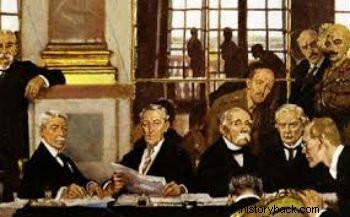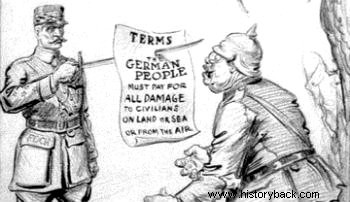The Treaty of Versailles it was a peace agreement sealed between the victorious powers of the First World War and the defeated Germany.
The process began with the armistice of November 11, 1918 and was signed on June 28, 1919.
Abstract
The Treaty of Versailles was characterized by French revanchism, the redefinition of borders, the establishment of indemnities and the creation of the League of Nations.
Participating Countries
The negotiations, which lasted six months, involved 70 delegates from 27 nations, including Brazil.
The defeated country, Germany, was left out of the transactions. Russia did not participate, as it had signed the Treaty of Brest-Litovsk with Germany in 1918.
Under the auspices of US President Woodrow Wilson, British Prime Minister David Lloyd George and French Prime Minister Georges Clemenceau, the Treaty of Versailles was concluded on June 28, 1919.
Despite being one of the main negotiators of the treaty, the United States Congress did not ratify the document nor did it join the League of Nations.
Thus, the US preferred to make a bilateral agreement with the Germans through the 1921 Treaty of Berlin.

French Revanchism
France sought in every way to avenge the defeat of the Franco-Prussian War. Not coincidentally, the Treaty of Versailles was signed in the same place where the French signed the treaty that had put an end to that conflict:the Hall of Mirrors at the Palace of Versailles.
The main clause of the Treaty of Versailles, Article 231, defined “war guilt” on Germany.
She was fully and solely responsible for all damages caused. Thus, the country should repair the nations involved in the conflict, especially those of the Triple Entente.
Indemnities and Territorial Losses
It was established that Germany should annually provide:
- seven million tons of coal to France;
- eight million tons of coal to Belgium.
It is worth mentioning that, in 1921, the amount in indemnities to be paid by Germany for the losses of the War, was calculated in 33 billion dollars or 269 billion marks.
They were then reduced to 132 billion marks, not counting the amounts to be refunded as pensions to widows and others affected by the conflict, most of them in France.
This imposition led the German economy to an economic crisis that lasted throughout the 1920s.
Furthermore, Germany lost 13% of its territory in Europe and thus 7 million citizens. It was determined that:
- the region of Alsace-Lorraine would be returned to France;
- Sonderjutland would pass to Denmark;
- Prussian regions such as Posen, Soldau, Warmia and Masuria would be incorporated by Poland;
- Hlučínsko passed to Czechoslovakia;
- Eupen and Malmedy become territories of Belgium;
- the province of Saar would be controlled by the League of Nations for 15 years.
The German colonies that represented more than 70,000 km 2 , distributed among Africa, Asia and the Pacific, were also affected. The colonies in Africa were divided between England, Belgium and France.

Military Demobilization
In military terms, it was determined the disarmament of the German people, the abolition of compulsory military service and the reduction of the army to 100,000 volunteer soldiers.
To prevent the development of the war industry in Germany, the manufacture of tanks and large-caliber weapons was prohibited. Along the same lines, the left bank of the River Rhine should be demilitarized.
To the same extent, the Navy could be composed of up to 15 thousand sailors and the German aeronautics was declared extinct. Many ships were delivered to the winners.
Military Schools and paramilitary associations were extinguished. This was a severe blow to a nation that had made military life one of its hallmarks.
Months later, through the Treaty of Saint-Germain-en-Laye, Austria was also forced to reduce its military strength to 30,000 men.
Consequences
German ministers Hermann Müller (Foreign) and Johannes Bell (Transport) signed the document on behalf of the Weimar Republic. Later, the Treaty of Versailles would be ratified by the League of Nations on January 10, 1920.
In short, this treaty has extremely punitive political, economic and military dimensions and its 440 articles are a true condemnation of Germany.
Despite officially ending the war, this convention was responsible, at least indirectly, for the fall of the Weimar Republic (which replaced the destitute German empire). Likewise, for the rise of Adolf Hitler and the Nazi party in 1933.
Learn more about the Aftermath of World War I.
Read more :
- World War I
- Brazil in World War I
- Phases of the First World War
- Trench Warfare
- Beginning of World War II
- World War II
- Fascism
- Questions about the First World War
- Films about the First World War
